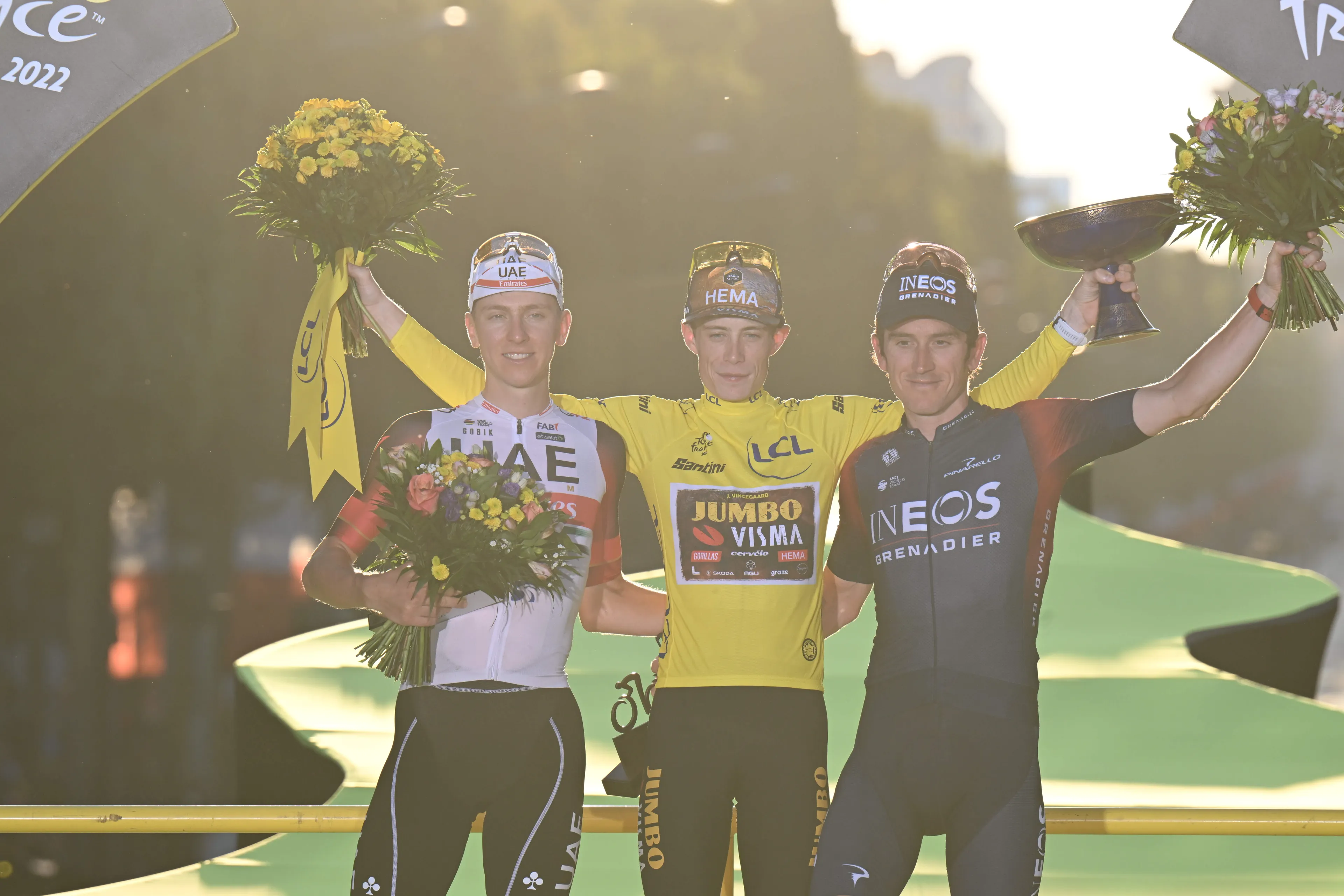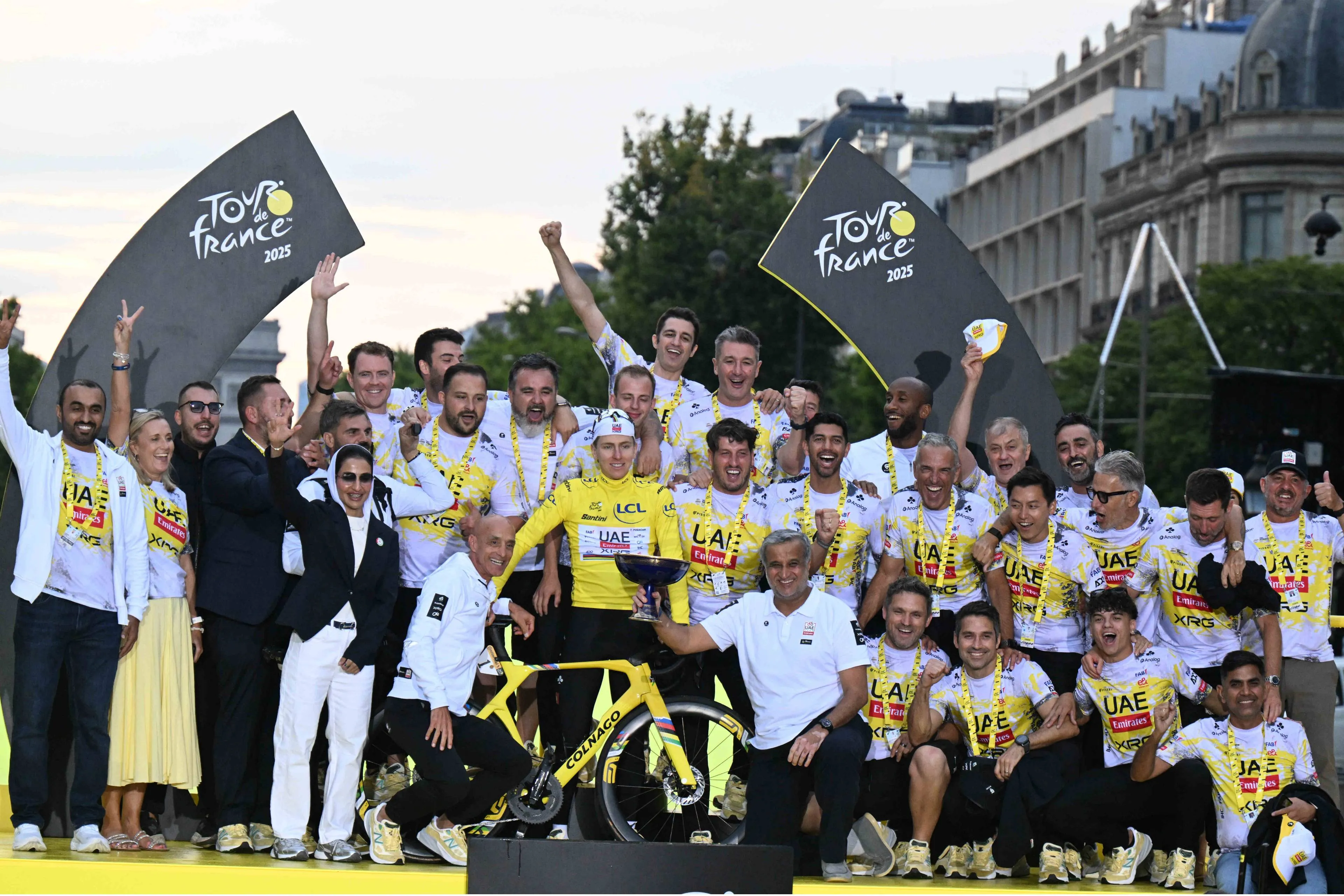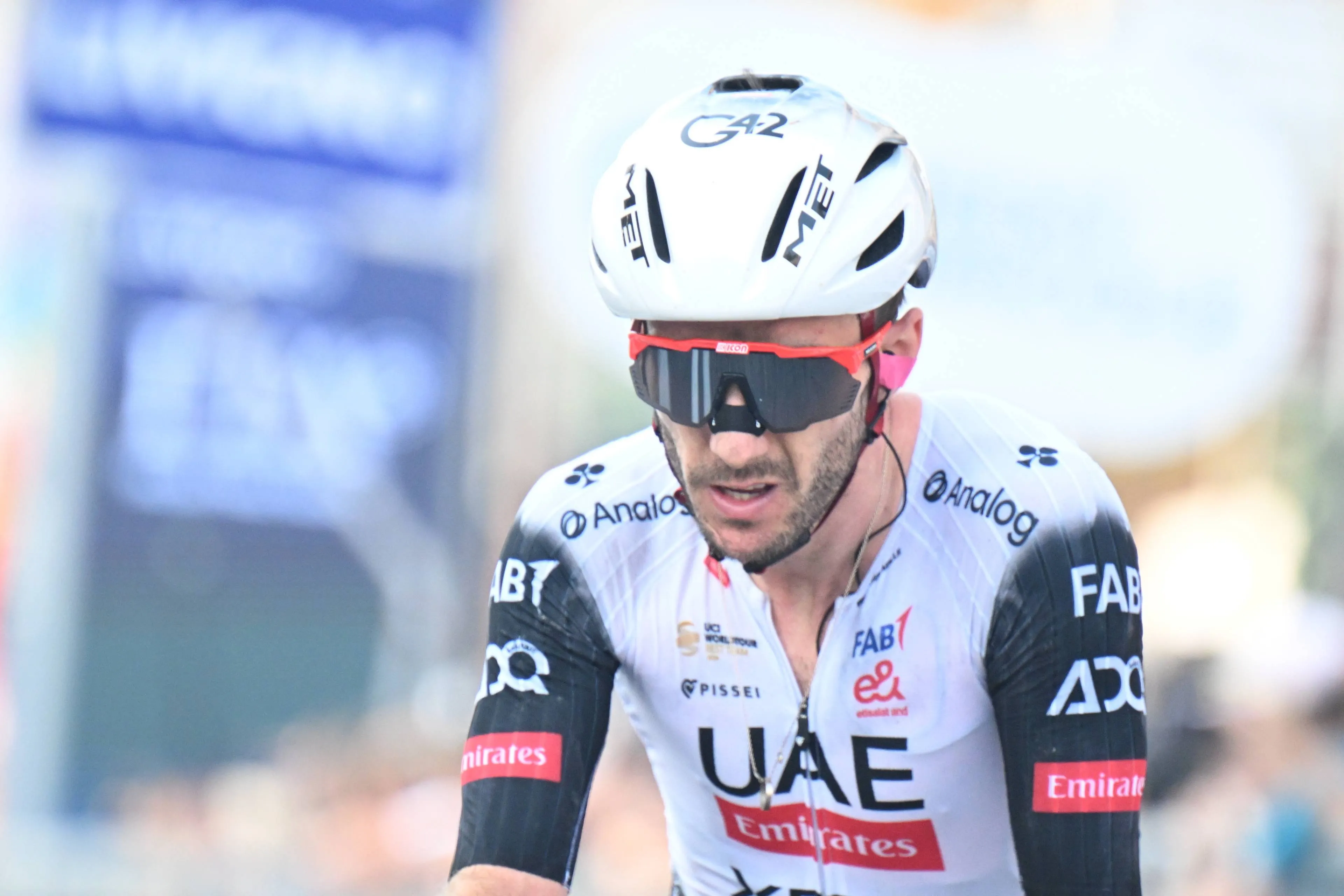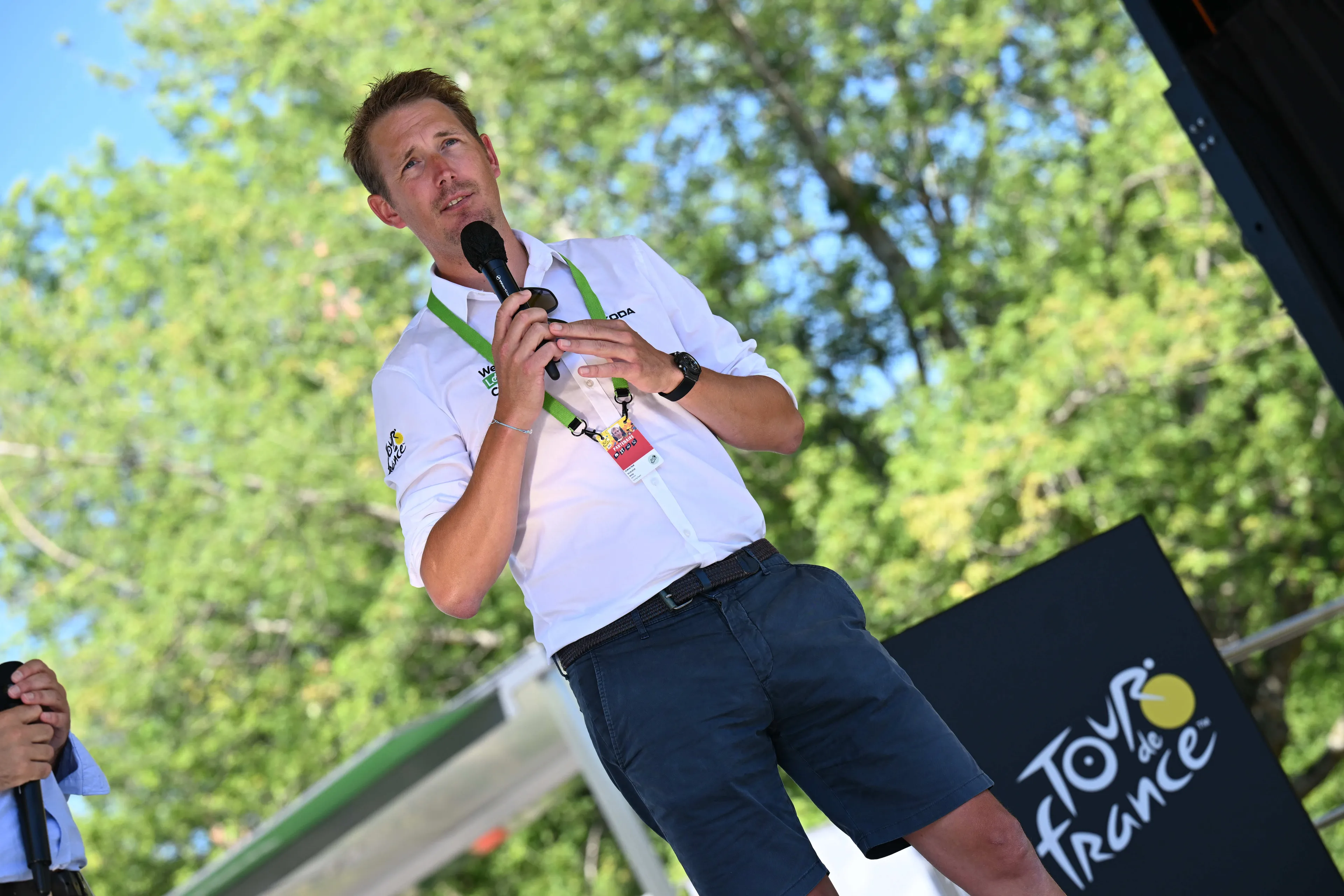Tour de France 2022 Stage Analysis | Profiles Tour de France 2022
CyclingSaturday, 02 July 2022 at 10:32
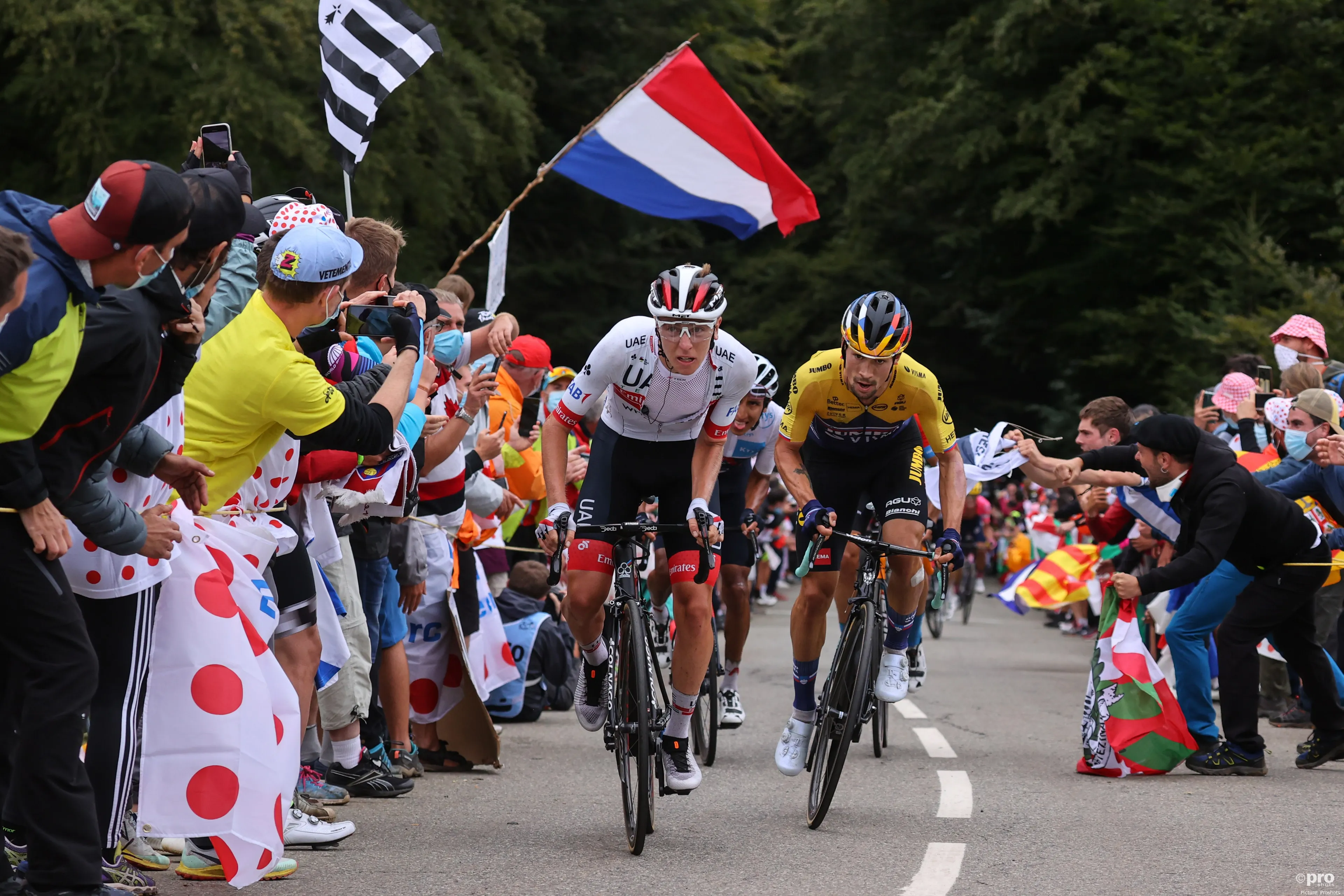
From the 1st to the 24th of July the peloton will be in the roads of France, Denmark and Switzerland for the 109th edition of the Tour de France. The most iconic, popular and one of the most important races for most of the riders and teams, who will be fighting for meaningful wins over the course of three weeks.
Here you will be able to see the profiles and detailed explanations of every one of the 21 stages that the peloton will be facing this July.
Create your own team in the Fantasy Tour de France: At least 25,000 euro/21,295 GBP in prizes!!
Read also
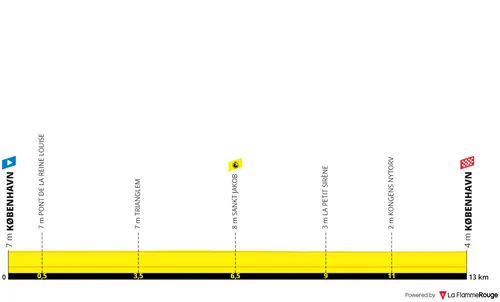
Stage 1 (ITT): Copenhagen - Copenhagen, 13Km
The Tour de France starts here, in Copenhagen. The Grand Depart will
this year be in Denmark, and the opening day will see a short but explosive
13.2 kilometers in the streets of the Scandinavian capital. A pan-flat route, however one that will present some challenges to the
riders in a great quantity of corners spread evenly throughout the course. This means that those looking for the stage win will also have to
be willing to take great risks in order to win every second possible on the
route.
Read also
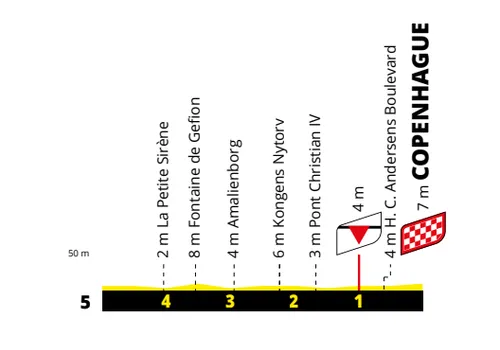
Stage 1

Stage 2: Roskilde - Nyborg, 199Km
The second stage will be the largest of the race’s Danish section, with
202 kilometers on the menu serving up the first opportunity for the sprinters.
It isn’t a complicated day, mostly pan-flat, however the three fourth category
climbs and the intermediate sprint in the middle of the day will see some
action. The day can also be marked by the wind. Although in the profile it isn’t
clear, the riders will go over the 16.2-kilometer long Grand Belt bridge. It
will be as exposed as it can be, a straightforward section where tension will
be very high and chaos can emerge if the wind is particularly strong on the
day.
As for the finale inside Nyborg it isn’t too complex, with the exit off
the bridge seeing the riders head into the town center. The last corner comes
with 750 meters to go, and from there on it will be a furious finale where the
sprinters will show their strengths.
Read also

Stage 2 Finale
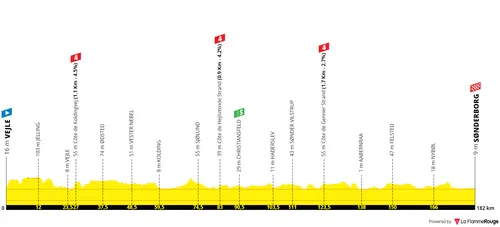
Stage 3: Vejle - Sonderborg, 182Km
The third day of the race will see the peloton head south towards
Germany. Although it will not reach it, the 182-kilometer long route will head
towards Sønderborg for what should be the second bunch sprint of the race. The stage starts in the city of Velje, there aren’t many features to the
day that can deal damage on the riders besides the weather and the tension. The
day isn’t pan-flat, however it also doesn’t include any meaningful ascent where
the sprinters could be put into difficulty.
The final sprint isn’t too technical, however the final ten kilometers
will surely see a significant fight for positioning In order to avoid crashes.
Near the city center with just under 10 kilometers to go there will be some
technical sections, but then the roads open up towards the finale. The final
corner will be inside the final kilometer, however this is a finale where
timing the leadout to the very last possible moment will be crucial in order to
deliver the sprinter in prime position.
Read also

Stage 3 Finale
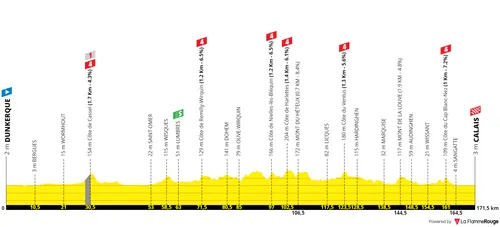
Stage 4: Dunkerque - Calais, 172Km
In the fourth day of racing the peloton returns to France. The stage
will take place in the very northwestern corner of the country, with a start in
Dunkerque and a finale in another coastal town, Calais. 171 kilometers to be travelled, not a particularly long stage, however
the toughest up to date. A bunch sprint should be clear, however there will be
opportunities to deal some damage. The day will see six fourth category ascents
including the cobbled Mont Cassel early in the day.
With 11 kilometers to go the riders will go through the Côte du Cap
Blanc-Nez, only 1 kilometer long but averaging 7% and with a furious leadout
into it certain. Some sprinters will be suffocated by it, and right after
follows the dash to the line. The riders will ride through three roundabout just before the 2
kilometer to go sign, and inside the riders will face corners with 1.4Km t go
and then with 600 meters to go. A more dangerous finale, pan-flat and with what
is sure to be a very tense run-in to the final turn.

Stage 4 Finale
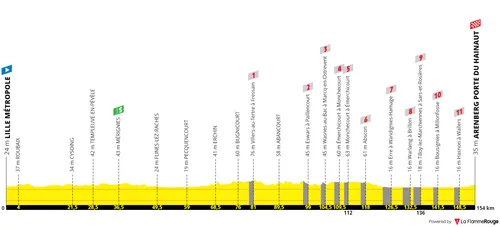
Stage 5: Lille - Wallers-Arenberg, 155Km
The fifth stage of the Tour de France may be the most tense. Perhaps the
first crucial day for the general classification, not because of the attacks
that can be made, but more so because of the time that can be lost on the
famous cobbles of northern France. The day will be short and quick, with only 153 kilometers departing from
Lille and finishing on the doorstep of the Trouée d’Arenberg – the town of
Arenberg Porte du Hainaut. On the way, 19.4 kilometres of cobbled roads, split
into 11 sectors mostly throughout the final 55 kilometers of the stage. It will
truly be a stage of two halves, with only the intermediate sprint located early
in the day, and the second half will be tense, fast and very dangerous
Unlike Paris-Roubaix, stage win won’t be the only priority for riders
here. There will be a yellow jersey on the line, but most importantly the Tour
de France. The first sector will finish with 72 kilometers to go. Then the sectors
will finish at the respective distances: 54.5; 49; 44.5; 41.5; 36; 27; 31;
17.5; 12 and 5 kilometers to go. The sectors are also very evenly distributed,
with the smallest being 1300 meters long and the longest is 2400. The final sector will come with just five kilometers to go, from which
will certainly emerge a fractured race – with some riders fighting for the win
whilst others battling for the GC. The finale is simple, with a long straight
in Arenberg deciding the stage winner.
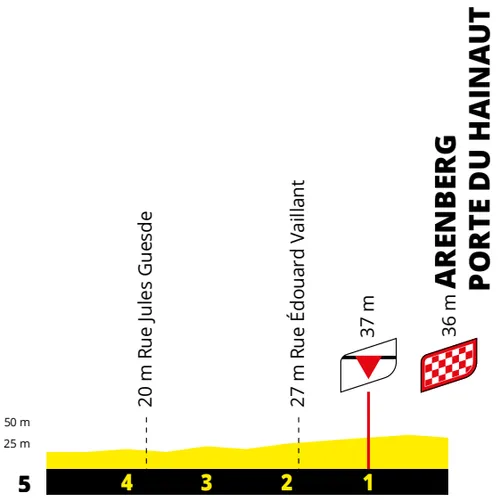
Stage 5 Finale

Stage 6: Binche - Longwy, 220Km
Stage six will be the first hilly day of the race. The start will be in
Binche, as the peloton will travel to Belgium overnight. This will be the
longest stage of the race with 220 kilometers in total. This is a day for the
Ardennes classics specialists to thrive. The start is relatively flat and will
see the riders return to France, for a finale in Longwy. Beforehand there will be some hilltops. 15Km to go (1.6Km; 4.1%), 9.5Km
to go 2.3Km; 4.3%) will warm up the riders. This will be a traditional classics
day, where the riders who want to fight for the stage win will have to save their
one bullet to the perfect timing to have a chance at winning the stage.
As the riders enter the town they reach the summit of the Côte de
Pulventeux, 800 meters long at 12.3% average gradient. It’s a brutal ramp which
may see attacks, and summits with a mere 5.5Km to go. The final ascent will be
1.6 kilometers long at 5.8%, after a short but technical descent, it will
feature ramps up to 11% and be a perfect opportunity for the puncheurs.
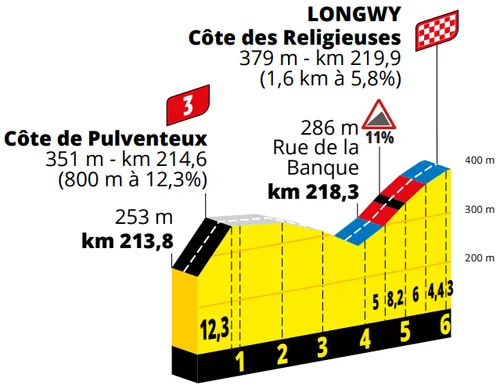
Stage 6 Finale
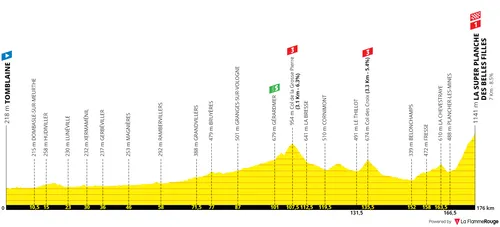
Stage 7: Tomblaine - La Super Planche des Belles Filles, 176Km
On the seventh day of the race the Tour de France reaches the mountains.
There will only be one day in the Vosges this year, but as is traditional the
Planche des Belles Filles will be climbed – once again. It is a 176-kilometer
stage that will be a “one-effort day” and should thin down the riders that will
be fighting for the top places in the race, as it’s the first real climbing
test. The first half of the stage is in it’s grand majority flat, without much
of an opportunity for there to be spectacle. The intermediate sprint will come
just after the 100-kilometer mark, and a sequence of hilltops will follow as
the riders enter the rugged terrain.
The riders will be focusing all their efforts on the final climb. The
leadout into the ascent should be furious so the effort will be a little
longer, and once the riders enter the hairpins the gradients will bite. The
climb is 6.9 kilometers long, it has a tough beginning with some sharp
gradients allowing for attacks to be dealt. However the finish will be in the ski area above, the “Super Planche”,
and so besides the tough ramp that used to take the riders into the finish
line, the riders will – like in 2019 – ride into a gravel sector and ride the
excruciating gradients into the finish.
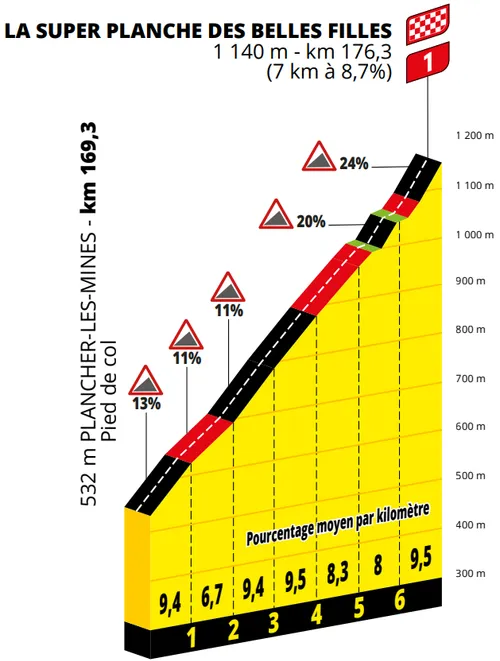
Stage 7 Finale

Stage 8: Dole - Lausanne, 184Km
Stage eight will see the riders once again change countries, as the
peloton will be heading into Switzerland for another finale away from French
territory. This 186-kilometer stage will be an interesting day, suited to a
breakaway but having a finale that will please the puncheurs, and even some
climbers who can nowadays be as explosive. There will be 2500 meters of climbing, however the winning effort will
with no doubt be the final ascent. Throughout the day the peloton will traverse
three categorized climbs, and the intermediate sprint before them all will also
ensure some action.
The day will end in the lake-side city of Lausanne, by the Olympic
stadium. It will be an explosive finale, where several types of riders can
thrive. The final climb is 4.8 kilometers in total with 4.6% average gradient,
however that only tells half the story. The climb is split into two sections, as the first two kilometers will
average just above 5% and will be used to shed those who can’t climb with the
best. There will be a whole kilometer with slight downhill gradients where the
riders can rest a bit, but surely with a furious pace into the toughest ramps.
The final 1.8 kilometers see 12% maximum gradient in the streets of Lausanne,
before ramping back down to a false-flat drag that will take the riders into
the line. A tricky finale to manage.
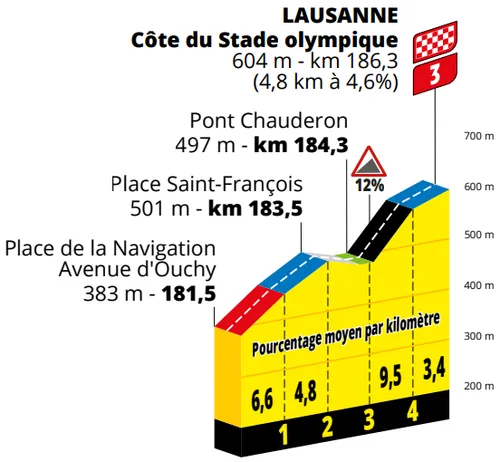
Stage 8 Finale
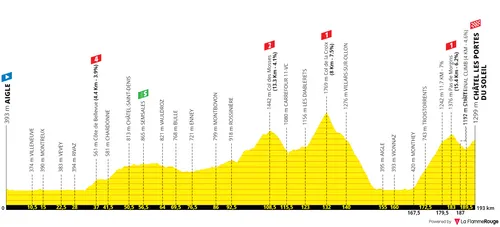
Stage 9: Aigle - Châtel les portes du Soleil, 183Km
At long last the race reaches the Alps. There will be four stages raced
in the region, and the ninth day is the first with true high mountains
involved. A long day with 193 kilometers on the menu, most of them on Swiss
territory before the finish in Châtel just across the border. The start of the stage, as almost all days, is flat. It will be in
Aigle, the headquarters of the World Cycling Center, and do a loop over the
mountains east of Lac Léman before returning to the Rhône valley and towards
France.
The Col de la Croix will come with 61 kilometers to the finish and is a
decent ascent. With some strong pace the peloton can shed quite some riders,
but mostly it can be used to deal some damage and prepare an attack for later
in the day. The descent will be long and somewhat technical, down
Villars-sur-Olon – which the riders climbed in a MTT at the Tour de Romandie. The stage will be decided in the final set of climbs. The first of which
is Pas de Morgins, 15.4 kilometers at 6.1%. The best climbers in the world can
fly up this, but truly it has to be said the ascent is 12 kilometers long at an
average of 7% as that’s where the attacks can come, afterwards moves should be
easy to cover. The ascent summits with 10 kilometers to go, and antecedes a
short descent before the rise to the line. The ascent into Les Portes du Soleil isn’t hard, however further gaps
can be extended if they’re made beforehand. The climb is 4 kilometers long at
4.6% average gradient and should see an exciting finale.
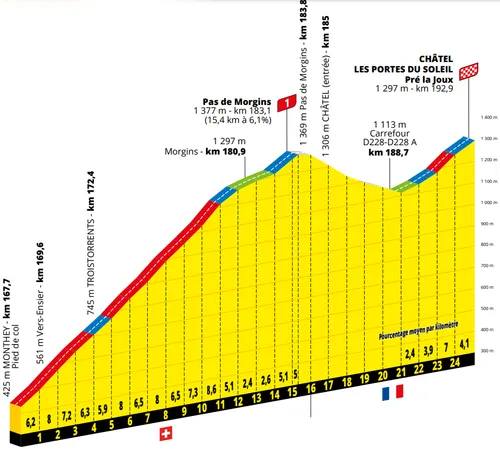
Stage 9 Finale
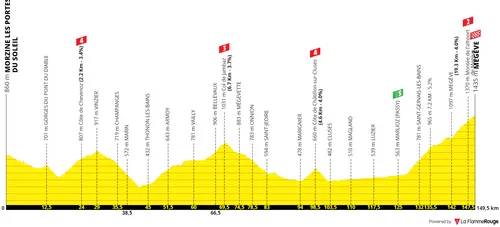
Stage 10: Morzine - Megève, 148Km
After the rest day comes a day which is very mixed. On paper, one for
the climbers, however on closer inspection many riders can succeed on such a
stage. It’s a short day as most mountainous days on this year’s edition are. It
starts off downhill, and has an initial ascent that summits on kilometer 28
which should see the breakaway go up the road and the race settle down. All climbs on this day are big-ring ascents, and so despite the initial
high-mountain appearance, the rouleurs and puncheurs also stand a chance. The
day sees a combination of rolling hills until the riders reach the base of the
final ascent.
That will be into the Megève Altiport. A long climb, with over 21 kilometers in distance but just over 4% in average gradient. The opening seven kilometers reach above that, but then long sections of pan-flat roads and some areas where the riders can rest and even slack on a few pedal rotations will see them recover. Hence, this isn’t a constant uphill effort, but more a combination of two ascents. The final one is over 7 kilometers long, it does feature flat-ish sections but it also has some rougher ramps and with the distance attacks may be more effective.

Stage 10 Finale
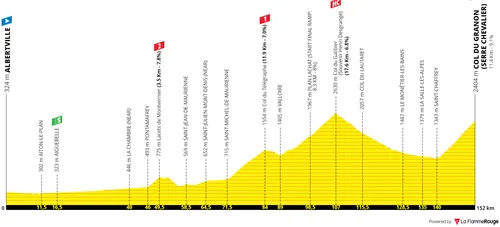
Stage 11: Albertville - Col de Granon, 149Km
Stage 11 will see the riders head into the high Alpine ascents. The Alps
come before the Pyrenees this year, and the short 151-kilometer day into the
Col du Granon can see serious differences and rearrange the overall
classification. The start in Albertville is flat, with an intermediate sprint
closeby, and the Lacets de Montvernier will be the first climb of the day
around 50 kilometers in. However it will be a mere warm-up for what’s to come.
The riders will head up the Souvenir Henri Desgrange. Although going up
it again the following day, on stage 11 the Col du Galibier will be climbed via
the Col du Telegraphe. The Telegraphe is 11.9Km long at 7% average gradient,
and the proper ascent to the Galibier will be 17.6Km long at 6.8%. This enough
is already a brutal combination, but it gets worst: The toughest ramps come
near the top along it’s many hairpins, and it will take the riders into 2630
meters of altitude. This can be a true challenge to many, and although most
will surely wait until the final climb, weaknesses can be exposed and seized –
it also is summited with 45 kilometers to go.
What will follow is a very fast descent into Briançon, technical at
first, but very simple and easy to chase on in it’s majority. Right before
reaching the town, the riders turn left into a surprising addition. The Col du
Granon will be the finale of this day, with 11.9 kilometers averaging 8.6%. A
very steady climb with harsh gradients and a summit at 2404 meters of altitude.
It’s a decisive stage, despite it’s early order in the race.

Col du Galibier

Col du Granon
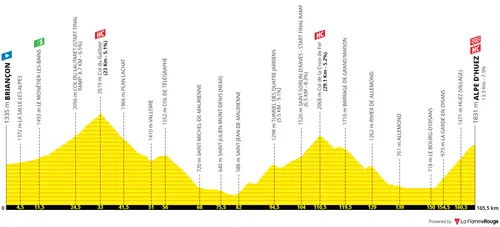
Stage 12: Briançon - L'Alpe d'Huez, 166Km
The riders descended into Briançon today and will be climbing back up it
tomorrow. Stage 12 is the final Alpine challenge, a day with three mythical
climbs that together form an extremely hard stage where the climbers will have
another opportunity to deliver serious damage. 165 kilometers and 4600 meters
of climbing. The riders immediately ride into the false flat of the Col du Lautaret.
It’s a long false-flat valley ascent, and will take the riders back up into the
Col du Galibier. Again altitude will be a challenge, the final 8.7Km have 6.5%
average gradients with the steepest ramps in sight of the summit, however at
this altitude all gradients are harder than what the numbers say. It comes
early in the day though, so mostly it should be the place to form a breakaway.
The next ascent will be the Col de la Croix de Fer. 29.1 kilometers at
5.2%, however with two descents in it’s bulk. It’s a hard ascent, with two
short but steep sections in it’s first half. It’s a very long effort though, so
most will be eyeing the final kilometers. Although altitude isn’t as high the
riders will ride over 2000 meters, and see 6.5 kilometers at 8.3% near the
summit – exposed and filled with hairpins, ideal for a long-range attack. It’s
summit comes with 55 kilometers to go.
After a long descent and a quick valley section the riders will arrive
at the base of one of the most iconic climbs of the Tour de France, Alpe
d’Huez. 13.9 kilometers at 7.9% average gradient, the maximum doesn’t go much
higher but it does come at the base. In several occasions the decisive attacks
have happened at the base. In others it came down to a sprint. Everything is possible depending on
the riders. This is a climb which will be packed with fans, packed with
hairpins, exhausted riders climbing at their best whilst others try to survive,
everything to see a real spectacle.
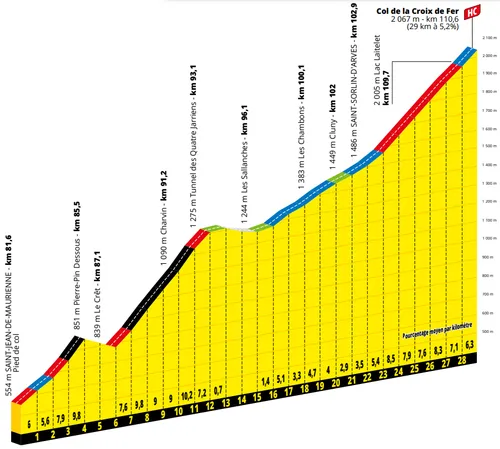
Col de la Croix de Fer
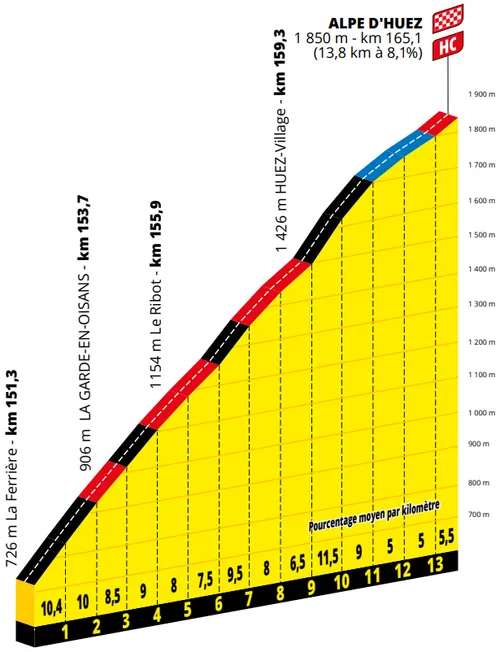
Alpe d'Huez
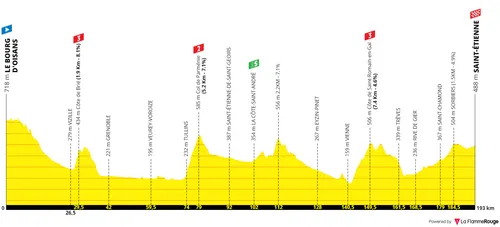
Stage 13: Bourg d'Oisans - Saint-Etienne, 193Km
The riders leave the Alps, to the
satisfaction of many, and heads directly into the Massif Central on the 13th
stage. The stage is 193 kilometers long, a long day on the bike with a few
climbs the peloton ride over, on a day that is however likely to finish in a
bunch sprint. The start will see a long descent, soon
after followed by a 1.9Km climb at 8.1%. This can be an issue for the sprinter
teams, who have here a spot where the breakaway hunters can attack and move off
from the peloton and establish a strong breakaway. It’s very much a transition
day, with a 5.2Km climb at 7.1% summiting with 114 kilometers to go that can
also be an obstacle for an organized chase. There will be some more hilltops,
however the most important is likely with 43.5Km to go, an hour away from the
finish, where the riders will ride up the Côte de Saint-Romain-en-Gal (7.4Km at
4.7%).
A descent will then follow another gentle rise, with a peak having 1.5Km at 4.9% finishing with only 8.5 kilometers to go. This is a stage where the sprinters who struggle uphill will have little chances, however a bunch sprint is the expected scenario in Saint-Étienne between those who don’t. The finale is relatively technical, albeit with a slight uphill tilt which will mean the sprinters will have a relatively clear run to the line.

Stage 13 Finale
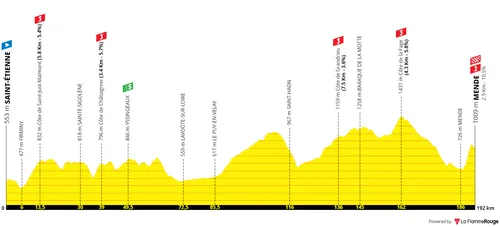
Stage 14: Saint-Etienne - Mende, 195Km
The 14th stage of the Tour de France will
see it’s hardest start aswell. The journey into Mende is rough, in the rolling
hills of the Massif Central, which will be the setting for what can be an
explosive day. 192 kilometers on the menu, which see the climbing begin after
six kilometers only, into a 55-kilometer long section packed with small climbs
and descents. Ideal terrain to form a strong breakaway group, some would
say. There’s almost 3500 meters of climbing on
this day despite the lack of a major climb. The Côte de Grandrieu (7.5Km; 3.6%;
56Km to go) and the Côte de la Fage (4.3Km; 5.8%; 30Km to go) will be warming
things up. In a breakaway possibly see decisive attacks, however in the peloton
they won’t do more than to build some more fatigue, before descending down into
Mende where the stage will explode.
The climb to the Col de la Croix Neuve is
no stranger to the Tour de France, having been tackled a few times in the last
decades. It’s one of the most famous climbs in the Massif Central and for good
reason - it consistently delivers good spectacle. Officially, it’s 2.9Km at
10.4% average gradient, a very explosive climb, with gradients that are quite
vicious in it’s hairpins, and where drafting will essentially be meaningless.
Unlike the efforts of the past days, it’s an anaerobic and explosive climb
which will force the climbers out of their comfort zone. This difference in
efforts alongside the fatigue can create some damage. The ascent summits with only just over a
kilometer to go, before a fast downhill run-up to the finish line in the local
airfield.
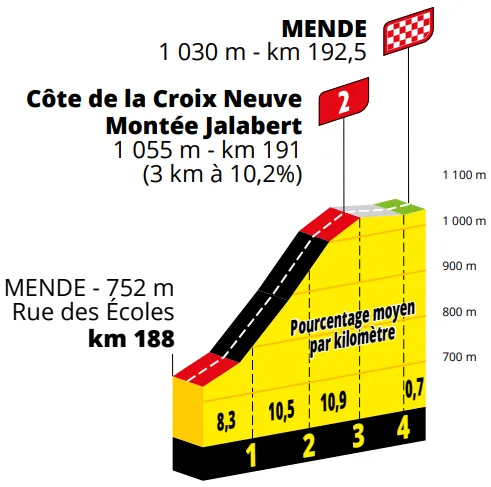
Stage 14 Finale
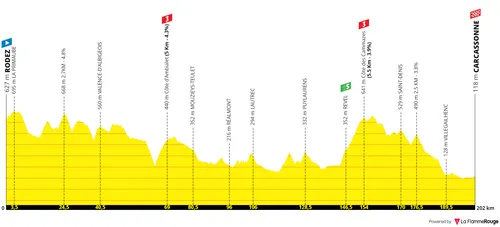
Stage 15: Rodez - Carcassonne, 200Km
The race is heading south into the
Pyrenees, but before the sprinters will once again have the opportunity to take
a stage win, or will they? Stage 15 will be a transition day, with some hills
en route to Carcassonne which will host a flat finale, but in no way one that’s
certain to end in a sprint. The start in Rodez sees some slight uphill ramps,
and very rolling terrain in which a breakaway can go up the road. Throughout the day, that is repeated time
and time again as there is a distinct lack of pan-flat roads. The stage has in
fact over 2400 meters of climbing, and over 200 kilometers in distance which
will make for a hard day under any circumstance. There are several small climbs
throughout the day, the main one summits with 48 kilometers to go - around 10
kilometers at 4%. Not a hard climb, but one the riders can do in the big ring
and with a strong group in front it can be very hard to cut the gap without
dropping sprinters in the peloton. What follows are 35 kilometers of mostly
downhill terrain, where again it can be very hard to cut down a gap. This means
the peloton has to ride hard all day long in order to achieve a bunch sprint.
The final 12.5 kilometers flatten out, however there
surely won’t be too much firepower to chase down a move in this distance if
this is the scenario. The final kilometers inside the city will be relatively
technical, with a few corners inside the final kilometer making it sketchy. The
finish will also see a slight bend to the left, which the sprinters will have
to take into consideration unless they find themselves in pole position for the
sprint.
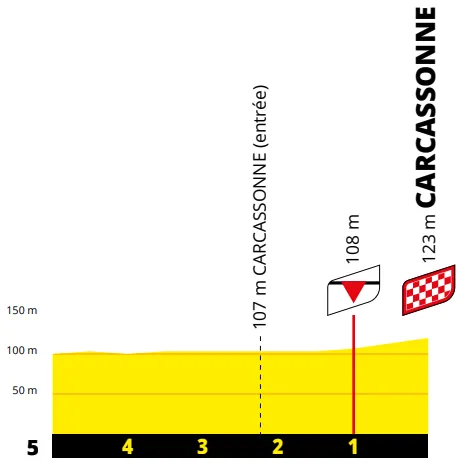
Stage 15 Finale
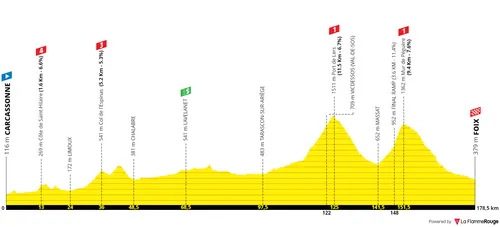
Stage 16: Carcassonne - Foix, 179Km
Stage 16 sees the race enter the Pyrenees. It will be
the final mountain range tackled in this year’s edition, and will see three
consecutive days where the overall classification can be changed. The first of
which will see the riders go from Carcassonne to Foix. The start of the stage
will have a couple of hilltops where a strong breakaway can go up the road, and
most of the day is then somewhat flat until the final combination of climbs. With 53.5 kilometers to go the riders will go over the
summit of the Port de Lers, the first ascent. It is 11.5 kilometers at 6.7%
average gradient, a constant climb which will prepare the riders into the final
challenge.
A somewhat technical descent will have the riders at
the base of the Mur de Péguère. Introduced in 2012, it has since became one of
the favourite climbs for the Tour de France organizers, who once again take the
finale into Foix. Before that though, the riders will climb 9.4 kilometers at
7.4%, an ascent split into two halves though, as the second half sees 3.6Km at
11.4%. Hard gradients which will be the focus of the climbers on the day, with
it’s summit coming with 27 kilometers to go. What will follow is a fast
descent, turned into a false-flat that will be ridden all the way into the
finale.

Port de Lers & Mur de Péguère
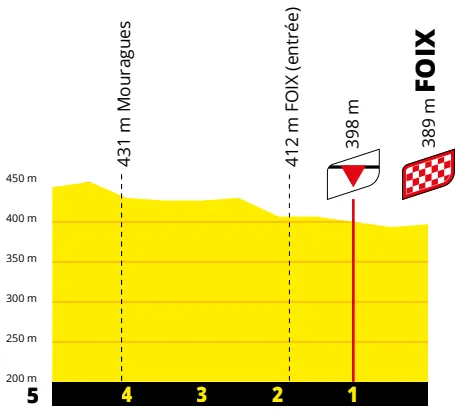
Stage 16 Finale
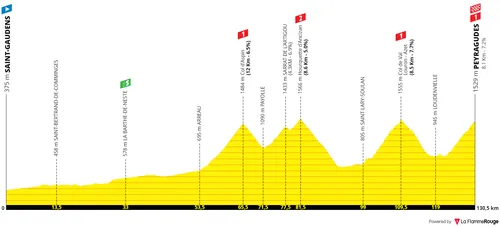
Stage 17: Saint-Gaudens - Peyragudes, 130Km
Stage 17 is a very short day, however with quite a lot
of climbing making up to it. The second day in the Pyrenees, with some of the
classics back on the route. In store will be only 130 kilometers, with the
first 50 being pan-flat meaning that very early on in the day the riders will
approach the final set of climbs that will decide the outcome of the stage, and
quite possibly change the appearance of the general classification. In those last 75 kilometers there are over 3000 meters
of climbing. First comes the Col d’Aspin (12Km; 6.5%; 65Km to go) which may see
some riders go up the road, although that’s an unlikely scenario. It will get
everyone ready for the following ascents. Shortly after the riders will go up
the easier vertent of the Hourquette d’Ancizan (8.6Km; 5.1%; 49Km to go).
A tricky descent will very quickly see the riders go
over another famous climb, the Col de Val Louron-Azet (8.5Km; 7.7%; 21Km to
go). Will this climb see much action? Unlikely due to the final climb, however
the very technical descent may stimulate some move, or get some pressure being
put on some riders, perhaps strategical racing with riders from the breakaway
dropping back.
The final climb though should be the decisive feature.
Instead of riding towards the summit of the Col de Peyresourde, this year the
peloton will head into Peyragudes, with the finale positioned in the Altiport -
the third of it’s kind throughout the race. It’s not a brutal climb, largely
similar to the ones tackled beforehand with 8.1Km at 7.2% average gradient. What
makes the difference is the altiport section in the final meters of the stage,
in which the riders go deep into double-digit gradients in a grueling dash to
the line.

Col d'Aspin & Hourquette d'Ancizan & Col de Val Louron-Azet
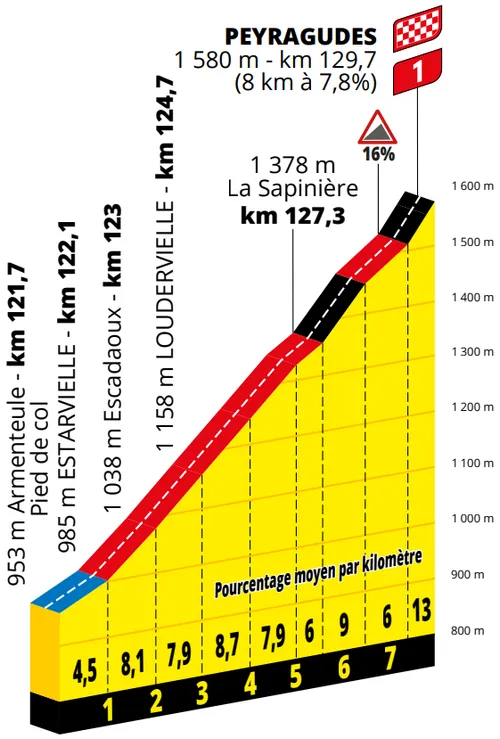
Peyragudes
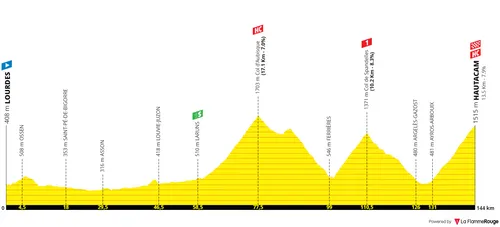
Stage 18: Lourdes - Hautacam, 143Km
Stage 18, the final day in the mountains. The formula
is exactly the same as today’s, with a flat start, short distance and a long
sequence of very similar climbs in the second half of the stage. The first 60
kilometers have little to describe, with mostly pan-flat roads leading into the
intermediate sprint, and into the hattrick of climbs.
The first is one of the hardest of the race, the Col
d’Aubisque, with 17.1Km at 7% average gradient, a very consistent ascent deep
into the mountains, with it’s summit with 76.5 kilometers to go. An
inconsistent descent follows, but leads directly onto the second climb of the
day. Which is the Col de Spandelles. Not as famous as
Aubisque, however a tough climb in it’s own right, averaging 8.3% throughout
10.2 kilometers. It summits with 33.5 kilometers to go and will certainly be
used to deal further damage in all riders.
The final climb will be to Hautacam, the final true
climb of the race. It is imagined by the organizers to be the climax of a
three-week race in the mountains, with 13.5 kilometers at 7.9%. In evert
scenario, a climb hard enough to make serious differences, specially on the
18th day of a Grand Tour.
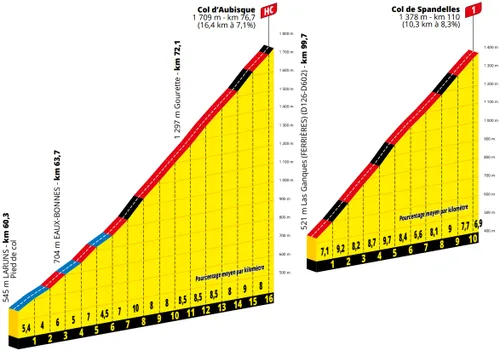
Col d'Aubisque & Col de Spandelles

Hautacam
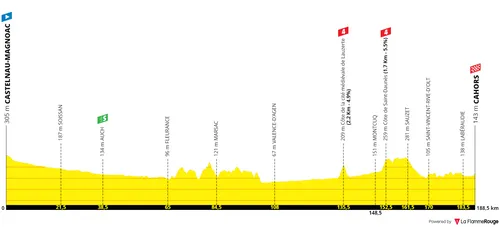
Stage 19: Castelnau-Magnoac - Cahors, 189Km
The traditional 19th stage being a
transition day. More of a logistics day for the Tour organizers who seek to get
closer to Paris due to the limit on stage transfers. Nevertheless a day of
racing, one for the sprinters, and a final opportunity for the rouleurs to
achieve a win which will make for some interesting dynamics. Castelnau-Magnonac will host the start of
a day that is mostly flat, with 188 kilometers to tackle and not many obstacles
ahead. A duo of fourth category ascents with 53 and 36 kilometers to go may be
the biggest threats to those who can’t climb very well, but it’s unlikely to do
any damage.
The stage is likely to be all about the sprint in Cahors. At this point of the race there shouldn’t be as much tension in the peloton, however there is expected to be a battle for positioning in the streets of the town, which will see a relatively technical finish with some tight bends in it’s final kilometers. As for the final straight it will point upwards, it won’t be a flat sprint, which can affect the outcome of the stage as not all riders will be happy to see gradients of around 4% in the final few hundred meters.
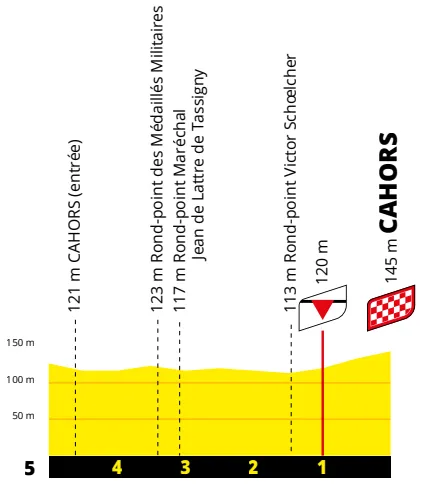
Stage 19 Finale
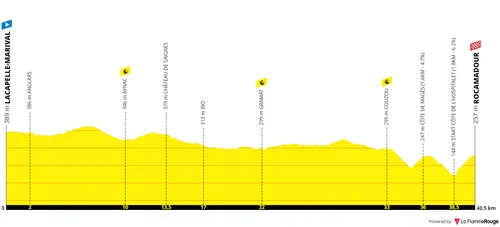
Stage 20 (ITT): Lacapelle-Marival - Rocamadour, 40Km
The final time-trial of the race. It can
be a crucial day for the overall classification, or at the very least an
interesting day with a Tour de France stage win up for grabs. The riders will
have 40 kilometers ahead to tackle, a very decent distance by today’s
standards, and definitely a day where serious differences can be made. The time-trial is rather hilly. Not one
where the specialists can’t put the power down, but definitely open to
surprises and with a tactical aspect to it. Until the third intermediate point
aftr 33 kilometers, the roads are very rolling, sometimes tilting up a bit,
sometimes tilting down, however in the map it’s visible that it doesn’t go
through straightforward simple roads. This won’t be favourable to the
specialists, however this is where they have to make their difference.
In the final section the riders will
encounter two descents and two hilltops - one coinciding with the finish line
in Rocamadour. The first of which is 1.6Km long at 4.7%, nothing serious, but
the second into the finish can be quite hard to manage for those who haven’t
saved their legs. The final ascent to the town center is 1.8Km long at 6.2%,
with it’s toughest gradients near the base. It will be a very sharp effort at
the end of a long time-trial.
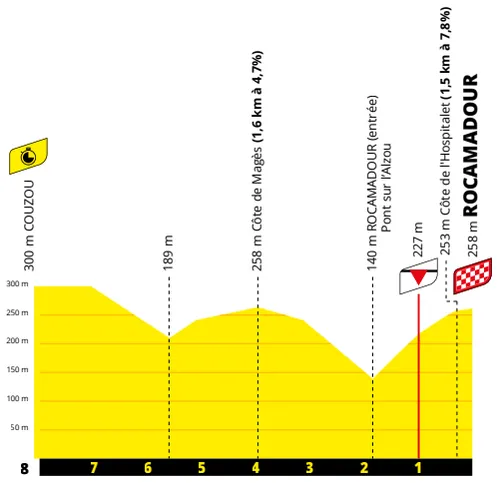
Stage 20 Finale

Stage 21: Paris La Défense - Paris (Champs-Élysées), 112Km
Finally the riders make it into Paris. The final day
is a tradition at the Tour de France, where the riders will ride calmly and in
celebration for a large portion of the day before the real racing begins. In
total it’s only 115 kilometers, and the final 55 will be ridden in Paris where
a sharp hour of racing will likely see a bunch sprint.
Attacks can succeed however, as the peloton is thinned down and worn out here, and for rouleurs they still carry a chance of succeeding, however their chances are always low. A bunch sprint is the traditional outcome, in the streets of Paris and the finale at Champs-Élysées. The finale is a bit technical, but very familiar to the riders who will ride the circuit 8 times. The Grand finale of the Tour de France!
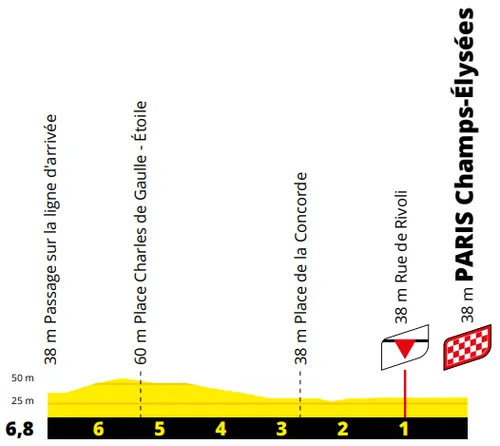
Stage 21 Finale
claps 0visitors 0
Just in
Popular news
Latest comments
- Uijtdebroeks is just a malcontent. he has never won anything. he will do nothing with Movistar. I would let Remco go for 7 million too. he's great, but not worth it. pay 10 million for Ayuso? also nuts.mij19-12-2025
- interesting Mads got 2nd at Flanders, and he isn't even mentioned by Wout LOL. makes me laugh how he is so overlooked.mij19-12-2025
- I think a 3 v 1 finish with the 1 being a good rider, but not great, is close to humiliation.mij19-12-2025
- These whiners simply want to keep their hold in the highest echelons of the sport without having to perform well enough to please their sponsors and remain there. Cycling has been "unsustainable" ...for 130 years! If Vaughters wants to leave the sport, there will be hundreds of teams happy to ride the Tour and the biggest races in the world in his place. That's what happens when there's a ton of supply of teams and a limited amount of demand for teams at the highest level! -An Economistacem8219-12-2025
- If she was Dutch or Belgian she'd have already sorted a team out. Unfortunately, the CX teams are pretty insular to 'foreigners' and would rather give a spot to a local rider. And that is one reason why the sport is niche outside its heartland.wipperman9519-12-2025
- Dear Editor: It is no humiliation to make the final, even with two riders, and not get it perfect against another talented rider. Disappointment, sure.itsent18-12-2025
- I luv this guy ,so honest puts the hand up ..."my fault.".. I would be stoked to see him win his big monuments ... i think he would be a great team mate and friend.Davide18-12-2025
- In his years in the peloton, Evenepoel has had several major crashes that could have ended another person's career. In that, he is sadly similar to Roglic, whose crashes have had a huge impact on his still impressive palmares. I'd say the first thing that needs to happen is that everyone make it to the Tour safely. At that point? I don't think they stand a chance against the UAE engine, and the man who is only now (seriously?!) coming into what used to be the age of maturity, refinement, and full bodily development.RidesHills18-12-2025
- It must be hard for him to let go...somewhere in his mind he sees himself competitive. The reality of his entire time at IPT tells a different story altogether.Crashjames18-12-2025
- Not only that, but aside from JV, no one has remotely come close to Tadej level, and I seriously doubt Remco or Lipowitz will be there next year in the finales. That said, a lot can happen on the road in the next year, and I hope it's an epic battle among all of the top 10 finishers. It's a little anticlimactic to watch Tadej ride everyone off his wheel, even if it is super impressive to watch.Crashjames18-12-2025
Loading
Write a comment

